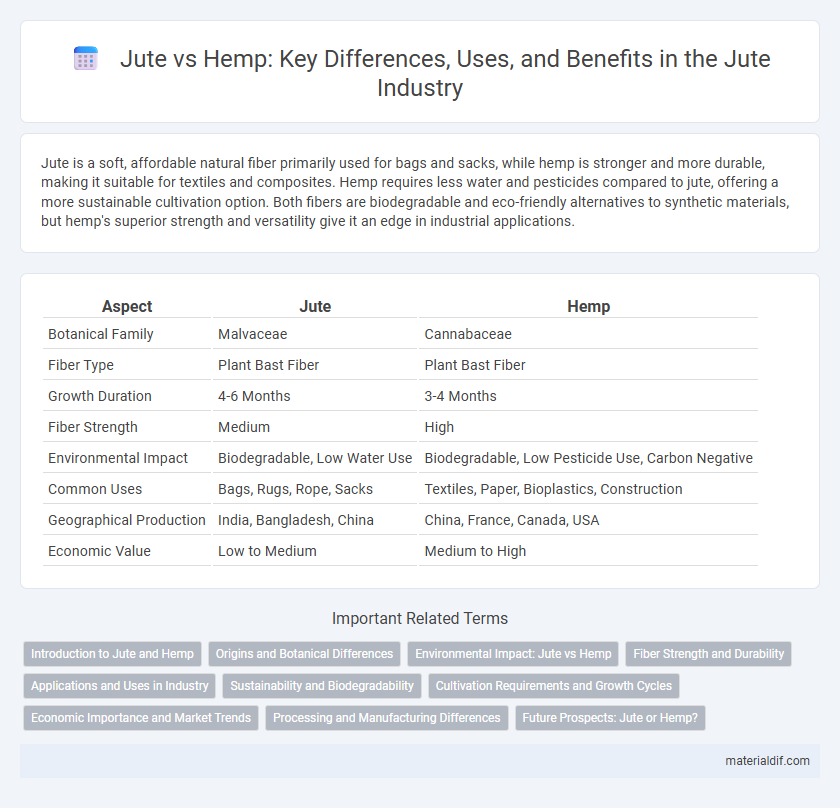Jute is a soft, affordable natural fiber primarily used for bags and sacks, while hemp is stronger and more durable, making it suitable for textiles and composites. Hemp requires less water and pesticides compared to jute, offering a more sustainable cultivation option. Both fibers are biodegradable and eco-friendly alternatives to synthetic materials, but hemp's superior strength and versatility give it an edge in industrial applications.
Table of Comparison
| Aspect | Jute | Hemp |
|---|---|---|
| Botanical Family | Malvaceae | Cannabaceae |
| Fiber Type | Plant Bast Fiber | Plant Bast Fiber |
| Growth Duration | 4-6 Months | 3-4 Months |
| Fiber Strength | Medium | High |
| Environmental Impact | Biodegradable, Low Water Use | Biodegradable, Low Pesticide Use, Carbon Negative |
| Common Uses | Bags, Rugs, Rope, Sacks | Textiles, Paper, Bioplastics, Construction |
| Geographical Production | India, Bangladesh, China | China, France, Canada, USA |
| Economic Value | Low to Medium | Medium to High |
Introduction to Jute and Hemp
Jute and hemp are natural fibers widely used in textiles and industrial applications, both derived from plants but differing significantly in fiber strength and texture. Jute fibers, obtained from the Corchorus plant, are softer and primarily used in making burlap, sacks, and rugs, while hemp, sourced from the Cannabis sativa plant, offers stronger, more durable fibers ideal for ropes, composites, and eco-friendly textiles. The cultivation of jute thrives in warm, humid climates like Bangladesh and India, whereas hemp grows well in diverse climates and has a broader range of environmental benefits, including lower water usage and faster growth cycles.
Origins and Botanical Differences
Jute is primarily cultivated in the Indian subcontinent, especially Bangladesh and India, while hemp has a broader cultivation range including Europe, China, and North America. Botanically, jute belongs to the Corchorus genus and Malvaceae family, characterized by coarse fibers from the stem's bark, whereas hemp comes from the Cannabis sativa species, producing strong fibers from the stalk. Differences in fiber texture, growth conditions, and plant morphology underline their distinct agricultural and industrial uses.
Environmental Impact: Jute vs Hemp
Jute and hemp both offer environmentally friendly alternatives to synthetic fibers, with jute requiring less water and pesticides during cultivation. Hemp absorbs more CO2 per hectare than jute, contributing to better carbon sequestration and soil health. Both crops improve soil quality, but hemp's faster growth rate and higher biomass yield provide greater environmental benefits overall.
Fiber Strength and Durability
Jute fibers are softer and less durable compared to hemp, which boasts higher tensile strength and greater resistance to wear and tear. Hemp's robust lignin content contributes to its superior fiber strength, making it ideal for heavy-duty applications such as ropes and industrial textiles. Jute remains favored for its affordability and biodegradability, but hemp outperforms in longevity and durability for demanding uses.
Applications and Uses in Industry
Jute and hemp are both natural fibers widely used in industrial applications, but they differ significantly in their versatility and strength. Jute is predominantly used in packaging, such as sacks and bags, as well as in home furnishings like rugs and curtains due to its affordability and biodegradability. Hemp boasts higher tensile strength, making it ideal for textiles, ropes, biocomposites in automotive parts, and eco-friendly construction materials, expanding its industrial applications beyond those of jute.
Sustainability and Biodegradability
Jute and hemp are both sustainable fibers, but hemp has a faster growth rate and requires less water and pesticides, making it more eco-friendly. Both fibers are biodegradable, yet jute breaks down more quickly in natural environments, reducing long-term waste. Hemp's higher tensile strength contributes to its durability, supporting longer product life cycles with minimal environmental impact.
Cultivation Requirements and Growth Cycles
Jute thrives in warm, humid climates with temperatures between 20-40degC and requires annual rainfall of 1200-2500 mm, favoring alluvial soil conditions with good water retention. Hemp grows well in temperate climates with temperatures ranging from 13-22degC and needs moderate rainfall around 500-700 mm, tolerating a broader range of soil types, including sandy and loamy soils. Jute's growth cycle spans 4-6 months, whereas hemp matures faster within 3-4 months, making hemp a more versatile crop for varying agricultural timelines.
Economic Importance and Market Trends
Jute and hemp are both economically significant natural fibers with growing market demand driven by sustainability trends. Jute dominates in South Asia with a market valued at approximately $1.5 billion annually, primarily used in packaging, textiles, and geotextiles, while hemp's global market surpasses $5 billion, expanding rapidly due to its versatility in textiles, bioplastics, and construction materials. Hemp's higher yield per acre and regulatory advancements in North America and Europe are shifting market trends, positioning it as a strong competitor to jute in eco-friendly product sectors.
Processing and Manufacturing Differences
Jute fibers undergo a water-intensive retting process that separates the fiber from the stem, while hemp utilizes a dew-retting method that relies on natural moisture and microbes. Jute processing involves manual labor for stripping and washing the fibers, making it more time-consuming compared to hemp's mechanized decortication and scutching techniques that enhance efficiency. Manufacturing jute results in coarser, less durable textiles, whereas hemp fibers produce stronger, finer fabrics suitable for a wider range of industrial applications.
Future Prospects: Jute or Hemp?
Jute and hemp both show promising future prospects due to their sustainability and versatility in textile and biocomposite industries. Hemp offers faster growth cycles and higher tensile strength, making it ideal for industrial applications, while jute's affordability and widespread cultivation in South Asia ensure its continued economic relevance. Emerging innovations in fiber processing and eco-friendly products are likely to drive competitive advantages for both crops in global markets.
Jute vs Hemp Infographic

 materialdif.com
materialdif.com